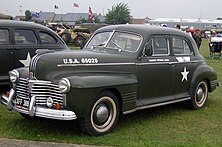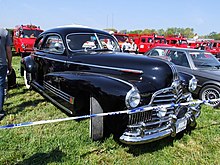
The Chevrolet Bel Air is a full-size car produced by Chevrolet for the 1950–1981 model years. Initially, only the two-door hardtops in the Chevrolet model range were designated with the Bel Air name from 1950 to 1952. With the 1953 model year, the Bel Air name was changed from a designation for a unique body shape to a premium level of trim applied across a number of body styles. The Bel Air continued with various other trim level designations, and it had gone from a mid-level trim car to a budget fleet sedan when U.S. production ceased in 1975. Production continued in Canada, for its home market only, through the 1981 model year.

The Oldsmobile 98 is the full-size flagship model of Oldsmobile that was produced from 1940 until 1942, and then from 1946 to 1996. The name – reflecting a "Series 90" fitted with an 8-cylinder engine – first appeared in 1941 and was used again after American consumer automobile production resumed post-World War II. It was, as it would remain, the division's top-of-the-line model, with lesser Oldsmobiles having lower numbers such as the A-body 66 and 68, and the B-body 76 and 78. The Series 60 was retired in 1949, the same year the Oldsmobile 78 was replaced by the 88. The Oldsmobile 76 was retired after 1950. This left the two remaining number-names to carry on into the 1990s as the bread and butter of the full-size Oldsmobile lineup until the Eighty Eight-based Regency replaced the 98 in 1997.

The Chrysler Imperial, introduced in 1926, was Chrysler's top-of-the-line vehicle for much of its history. Models were produced with the Chrysler name until 1954, after which it became a standalone brand; and again from 1990 to 1993. The company positioned the cars as a prestige marque to rival Cadillac, Continental, Lincoln, Duesenberg, Pierce Arrow, Cord, and Packard. According to Antique Automobile, "The adjective 'imperial' according to Webster's Dictionary means sovereign, supreme, superior or of unusual size or excellence. The word imperial thus justly befits Chrysler's highest priced model."

The Dodge Coronet is an automobile that was marketed by Dodge in seven generations, and shared nameplates with the same bodyshell with varying levels of equipment installed. Introduced as a full-size car in 1949, it was the division's highest trim line and moved to the lowest level starting in 1955 through 1959. The name was reintroduced on intermediate-sized models from the 1965 until 1976 model years. Muscle car versions were available starting in 1965 with the 383 and 426 wedge cu in Chrysler RB engine, followed in 1966 by the powerful 426 cu in Chrysler Hemi. Other performance models included the "Superbee", and featured, the 383 cu in Magnum, among other engine options. The nameplate "coronet" is a type of crown worn by royalty.

The Series 60 "Special" is a full-size car made by Oldsmobile from the 1939 through the 1948 model years. It was their entry-level model using the GM "A" body platform, giving Oldsmobile an entry level product with more standard features that would be optional on Chevrolet and Pontiac vehicles using the same platform. Initially, the engine size used was the company's flat head 6 cylinder, while senior models would use the flat head 8 cylinder. For marketing purposes, the Oldsmobile Series 60, or the Oldsmobile 66, took advantage of the national highway U.S. Route 66 established in 1926. It was with this generation that all GM vehicles experienced increased width dimensions to accommodate three passengers on the front bench seat and an additional three passengers on rear bench seat installed vehicles. This was accomplished with the deletion of running board thereby adding additional room inside the passenger compartment and upgrading the floor mounted gearshift to a steering column installed transmission gear selector for the Hydramatic automatic transmission.

The Oldsmobile Series 70 is a full-size midrange automobile produced by Oldsmobile between the 1939 and 1950 model years. Oldsmobiles of this time period were in an unusual "middle" position in GM's hierarchy of automobile brands. Chevrolet and Pontiac were the budget priced models, while Buick and Cadillac were the luxury brands. GM would share their "A" body platforms between Chevrolet, Pontiac, and "B" body on Oldsmobile and Buick, while leaving Cadillac on the senior "C" platform. Oldsmobiles were then branded as "luxury level" Chevrolet's and Pontiac's, while Oldsmobiles using the "B" platform were "budget priced" Buicks and Cadillacs.

The Buick Roadmaster is an automobile that was built by Buick from 1936 until 1942, from 1946 until 1958, and then again from 1991 until 1996. Roadmasters produced between 1936 and 1958 were built on Buick's longest non-limousine wheelbase and shared their basic structure with the entry-level Cadillac Series 65, the Buick Limited, and after 1940, the Oldsmobile 98. Between 1946 and 1957 the Roadmaster served as Buick's flagship.

Meteor was a marque of automobiles offered by Ford Motor Company of Canada from 1949 to 1976. The make was retired for the 1962 and 1963 model years, when the name was used for the Mercury Meteor sold in the United States. It succeeded the Mercury 114, a Canadian-market Mercury based on the Ford, the "114" name being taken from the car's wheelbase.

The Chrysler Saratoga is an automobile built by Chrysler. The nameplate was used from 1939 to 1952 and from 1957 to 1960 in the U.S. market, in Canada through 1965, and in Europe from 1989 to 1995. In the beginning, it was introduced as a sport luxury model, using the Straight Eight engine from the Chrysler New Yorker which was more formal, and the Imperial which had graduated to special order limousine.
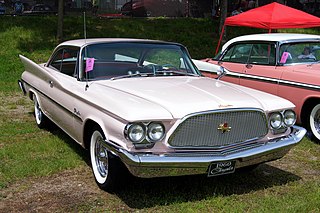
The Chrysler Windsor is a full-size car which was built by Chrysler from 1939 through to the 1960s. The final Chrysler Windsor sold in the United States was produced in 1961, but production in Canada continued until 1966. The Canadian 1961 to 1966 Windsor model was for all intents and purposes the equivalent of the Chrysler Newport in the United States.

The Cadillac Series 40-62 is a series of cars which was produced by Cadillac from 1940 through 1964. Originally designed to complement the entry level Series 61, it became the Cadillac Series 6200 in 1959, and remained that until it was renamed to Cadillac Calais for the 1965 model year. The Series 62 was also marketed as the Sixty-Two and the Series Sixty-Two. The Series 62 was used to introduce the Cadillac Coupe de Ville and the Cadillac Eldorado which started out as special appearance packages that were later placed into production.

The Cadillac Series 61 was Cadillac's mainstream product model range. It was priced and equipped more modestly below the limousine, GM D platform Cadillac Series 85, Cadillac Series 90, Cadillac Series 72, Cadillac Series 67, and Cadillac Fleetwood Series 75. It was upgraded to the Series 62 in 1940 only to return to production in model year 1941, replacing the cancelled LaSalle Series 50. While production was suspended from model years 1943–1945 due to World War II, it remained as the junior level product line until 1951. The size, equipment list and quality level were the most popular with buyers who wanted a prestigious luxury car that was usually driven by the owner, while the longer cars were chauffeur driven. It combined the most popular features of the previous Series 60 and Series 65 and was priced at the same level as Buick products of the time.

The Pontiac Chieftain is an automobile which was produced by Pontiac from 1949 to 1958. The 1949 Chieftain and Streamliner models were the first all new car designs to come from Pontiac in the post World War II years. Previous cars had been 1942 models with minor revisions.
The GM A platform was a rear wheel drive automobile platform designation used by General Motors from 1925 until 1959, and again from 1964 to 1981. In 1982, GM introduced a new front wheel drive A platform, and existing intermediate rear wheel drive products were redesignated as G-bodies.
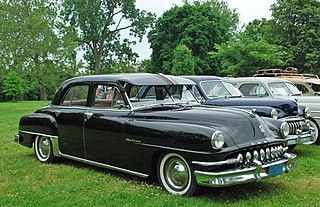
The DeSoto Series S-10 is an automobile produced by DeSoto from 1942 through to the 1952 model year. While in production, the Series S-10, which was sold with the trim package DeLuxe, was DeSoto's entry-level car, and was offered primarily as two-door and four-door sedans while the Custom offered upscale interiors and appearance including a 7-passenger sedan and the extended-wheelbase Suburban sedans. The body was claimed to be "rust proofed".

The 1949 Ford is a line of cars produced by Ford from the 1949 to 1951 model years. The successor to the prewar 1941 Ford, the model line was the first full-size Ford designed after World War II, becoming the first Ford car line released after the deaths of Edsel Ford and Henry Ford. From 1946 to 1948, each of the American Big Three concentrated on the restoration of car production, offering updated versions of their 1941-1942 model lines. Released in June 1948, the 1949 Ford was the first major "postwar" American car line, beating Chevrolet to market by six months and Plymouth by nine.

The Mercury Monterey is a series of full-size cars that were manufactured and marketed by the Mercury division of Ford from 1950 to 1974. Deriving its name from Monterey Bay, the initial Mercury Monterey served as the top-of-the-line two-door sedan model for 1950 and 1951 to compete with the hardtop models of Oldsmobile and Buick. It came with a vinyl roof covering, upgraded upholstery, and other features. The hardtop was introduced for 1952. During its production, the Monterey would be offered in multiple body styles, ranging from coupes, convertibles, sedans, hardtops, and station wagons.

The Buick Super is a full-sized automobile produced by Buick from 1940 through the 1958 model years, with a brief hiatus from 1943 through 1945. The first generation shared the longer wheelbase with the top level Roadmaster while offering the smaller displacement engine from the Buick Special. The Super prioritized passenger comfort over engine performance. For several years, it was called the "Buick Eight" or "Super Eight" due to the engravement on the grille while all Buick's since 1931 were all installed with the Buick Straight-8 engine with varying engine displacement.
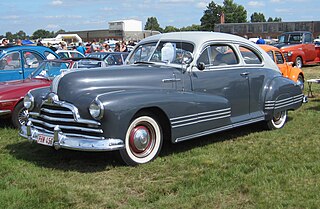
The Pontiac Streamliner is a full-size car produced under the Pontiac brand by General Motors from 1932 until 1952. A mass-produced and popular vehicle, it was a significant luxury car during the recovery from the Great Depression, and during and immediately after the Second World War.

The Dodge Custom is a full-size car which was produced by Dodge in the United States from 1946 to early 1949, and was also called the DeLuxe in a more basic trim package. Dodge was very fluid with model nameplates and during the 1930s updated them yearly based on marketing objectives, while the actual vehicle was largely unchanged for what became known as the "Senior Dodge's" that were available with shorter "Junior Dodges" that were essentially badge engineered Plymouth models during this time period.




